Publications
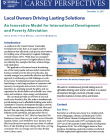
December 21, 2017
As outlined in the United Nations’ Sustainable Development Goals, there is an urgent need for mechanisms that effectively scale proven interventions for tackling some of humanity’s toughest challenges (United Nations 2015). While there are exemplary models that have proven to be highly effective, there are relatively few examples that have achieved large-scale replication.

December 20, 2017
This case study provides an overview of Ziweto Enterprises, a social venture using franchising methodology to scale its growth. The goal of this study is to present a clear picture of how the starting stages of a social franchise can expand and thrive in a developing country such as Malawi. By discussing Ziweto’s history, business model, operations, challenges, successes, decision-making process...
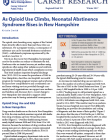
December 19, 2017
The opioid crisis besetting every region of the United States directly affects more than just those who use substances. For a pregnant woman, a consequence of substance use can be neonatal abstinence syndrome (NAS)—withdrawal symptoms experienced by the newborn (see Box 1).

December 18, 2017
The 2020 Census will have ramifications for every person in the United States, urban and rural residents alike.1 Interest in the Census is growing2 and the Census Bureau’s plans are becoming more concrete,3 but little has been written about the special challenges that will make some rural areas and populations difficult to enumerate accurately.

December 15, 2017
Low-income families with working parents face significant burdens paying for child care, which can function as a barrier to work and often means parents must rely on child care arrangements that are less formal and less stable.1 Amid national concerns about the high cost of child care, it is important to keep this issue at the forefront. Given the especially high costs of care for very young...

December 15, 2017
Working families with young children face substantial barriers in accessing and affording quality child care. Figure 1 shows that among working families with a child under age 3, those who do not pay for child care are more likely to live in poor or low-income families than those who do pay for child care (61 percent versus 45 percent).
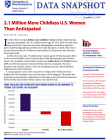
December 12, 2017
In 2016, there were 2.1 million more childless women of prime child-bearing age than anticipated. The 19.5 million women age 20–39 in 2016 who had never given birth was 12 percent more than demographers would have expected given child-bearing patterns just before the Great Recession. In 2016, there were 7 percent more women 20–39 than ten years earlier, but 22 percent more who had never had a...
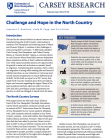
December 5, 2017
Hit hard by the national decline in natural-resource and manufacturing jobs, North Country communities in northern New Hampshire and bordering areas of Maine and Vermont (Figure 1) continue to face challenges in restructuring their economies.1 A 2008 study classified Coös County, New Hampshire, and Oxford County, Maine, as “amenity/decline” regions, a common pattern in rural America where...
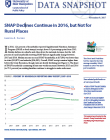
November 27, 2017
In 2016, 12.4 percent of households reported Supplemental Nutrition Assistance Program (SNAP, or food stamps) receipt, down 0.4 percentage point from 2015. Similar declines in suburbs and cities drove the national decrease, but the 14.8 percent of rural households receiving SNAP did not significantly change between 2015 and 2016.
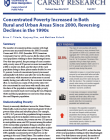
November 21, 2017
The number of nonmetropolitan counties with high poverty rates increased between the 2000 Decennial Census and 2011–2015 (hereafter 2013) American Community Survey (ACS), and so did the share of the rural population residing in these disadvantaged areas. Over this time period, the percentage of rural counties with poverty rates of 20 percent or more increased from a fifth to nearly one-third, and...
